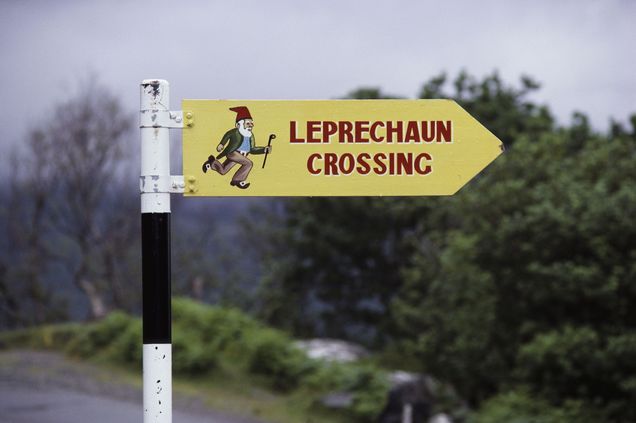The Leprechaun: A Tiny, Mischievous, and Elusive Creature of Irish Folklore
[source: History Cooperative]
A leprechaun is a mythical creature in Irish folklore, typically depicted as a tiny, mischievous old man dressed in green with a red beard and a hat.
According to legend, leprechauns are cobblers by trade and are known for their love of gold and their skill in making shoes. They are also said to be very secretive and elusive, often leading people on wild goose chases in search of their treasure.
In Irish mythology, it is believed that if you catch a leprechaun, he must grant you three wishes in exchange for his release. However, leprechauns are notoriously difficult to catch, as they are quick and clever.
What is a Leprechaun?
Usually classed as some kind of a fairy, leprechauns are small supernatural creatures that are specific to Irish folklore. Depicted as little bearded men, they might play the role of mischievous sprites or helpful shoemakers, depending on the story. They are strongly associated with gold and wealth and are meant to be a test of a human’s greed. In the modern world, the leprechaun has become an enduring symbol of Ireland.
What Does ‘Leprechaun’ Mean?
The English word ‘leprechaun’ is derived from the middle Irish ‘luchrapán’ or ‘lupraccán.’ These in turn were descended from the old Irish ‘luchorpán’ or ‘lupracán.’ The most common meaning given for the name is a compound of the root words ‘lú’ or ‘laghu’ and ‘corp.’ ‘Lú’ or ‘laghu’ is from the Greek word meaning ‘small’ and ‘corp’ is from the Latin ‘corpus,’ which means ‘body.’
Another more recent theory suggests that the word is derived from the Luperci and the Roman pastoral festival Lupercalia.
Finally, local folklore theorizes that the name may be derived from the words ‘leith’ meaning ‘half’ and ‘bróg’ meaning ‘brogue.’
Since a local alternative spelling for leprechaun is leithbrágan, this may be a reference to depictions of the leprechaun working on a single shoe.
Appearance
While the modern perception of the leprechaun is a mischievous looking little being dressed in a green suit and top hat, the fairy legends have a very different portrayal of them. Leprechauns traditionally took the form of an old man with a white or red beard. They were no larger than a child, wore hats, and were usually depicted sitting on toadstools. They had old, wrinkled faces.
There is a more modern interpretation of the leprechaun – a creature whose jolly round face rivals the bright green of his clothing. The modern leprechaun is usually smooth-shaven or has a red beard to contrast his green clothing.
Clothing
In Irish mythology, fairies were usually depicted wearing a red or green coat. The older variations of the leprechaun would usually wear red jackets. The Irish poet Yeats had an explanation for this. According to him, the solitary fairies like the leprechaun traditionally wore red while the fairies who lived in groups wore green.
The leprechaun’s jacket had seven rows of buttons. Each row, in turn, had seven buttons. In certain parts of the country, the leprechaun wore a tricorn hat or cocked hat. The outfit also varied depending on the region the myth was from. The northern leprechauns were dressed in military coats and the leprechauns from the wild west coast in warm frieze jackets. The Tipperary Leprechaun appears in an antique slashed jacket while the leprechauns of Monaghan (also called cluricaune) wore a swallow-tailed evening coat. But they were usually all red.
The later interpretation that leprechauns wear green may be because green was a traditional national color of Ireland from as early as the 1600s. The dress style of the leprechaun also changed to reflect the fashion of Irish immigrants coming to the United States.
In tales and portrayals where the leprechaun is making shoes, he might also be depicted wearing a leather apron over his clothes.
Characteristics
Leprechauns are thought to be tiny, incredibly agile goblin or fairy figures. They are typically solitary creatures and the guardians of hidden treasure. This is why they are so often depicted with pots of gold coins in the old tales. The traditional tales of leprechauns talk of stern, gloomy, bad-tempered old men. They are said to be frequently quarrelsome and foul-mouthed and their purpose is to test human beings on their greediness. They are also often associated with craftsmanship.
The more modern interpretation of a leprechaun as a cheerful little soul sitting on a toadstool is not authentic to Irish folktales. That is a more universal European image that appeared due to the influence of fairy tales from the continent. This version of the leprechaun seems to enjoy playing practical jokes on human beings. While never as dangerous or malicious as some of the Irish fey, these leprechauns are only interested in making mischief for the sake of it.
Leprechauns are so often associated with gold and wealth that it almost comes as a shock that their exclusive career choice is to be cobblers. That doesn’t sound like a very lucrative profession if you think about it. However, firm believers in leprechauns go searching for them to see if they can retrieve the gold.
D. R. McAnally (Irish Wonders, 1888) says that this interpretation of leprechauns as professional cobblers is a false one. The fact is that the leprechaun only mends his own shoes very often since he runs about so much and wears them out.
No Female Leprechauns?
One interesting fact about leprechauns is that they are exclusively male. Irish folklore always depicts these creatures as bearded elves. If there are no women, where do baby leprechauns come from then, you might ask? There is no answer to this question. There aren’t any accounts of female leprechauns in history.
_________________________________________________________________☘️
The Leprechaun
[source: Emerald Isle]
Irish and Celtic myths and legends, Irish folklore and Irish fairy tales tales of Ireland
The Leprechaun, red capped and jolly...
The cheerful Leprechaun is about as well known an emblem of Ireland as you could want, but what truth lies behind the stories? Well the truth is nobody really knows the truth, for leprechauns are are a cagey bunch at the best of times, not prone to gossip or holding forth on the important events of the day or the local hurling results, even after a few drops of whiskey.
Some say they wear green coats with red buckles, and others that they wear red coats with green buckles, but everyone agrees that their shoes are always of the finest leather and polished to a nicety, so much that you can see your reflection in them even on a moonless night. For the leprechaun is the the fairy cobbler, and they have great need of his services for they dance every day and all day.
The leprechaun is paid in fairy gold, although stories tell that they chased around after the Vikings when they were up to mischief as well, collecting dropped gold and hiding it in their treasure troves. And well they might chase the Dane, for the whole idea of the little man in the red is rooted in Scandinavian folklore rather than Irish.
They watch over any gold left laying about and are mighty slow to spend any of it!
And even when they do, beware, for a leprechaun's pockets hold two coins, one of silver and the other of gold. The silver one always returns to his pocket and the gold, well it turns to damp leaves and dust when the moon rises, even after they get their change.
For all that they have a reputation for being tight lipped, when they do speak their wit and wisdom are famed, although be sure not to allow the conversation to stray into matters of stature, for they have a tendency towards being on the diminutive side and sensitive with it. Indeed, their shoes are often high-heeled and they wear tall hats, the better to seem taller!
If you do happen to stop and chat with a leprechaun though, see if you can't catch a hold of him, for he might well lead you to where his treasure is buried, in exchange for his freedom. But never take your eyes off him for he'll be gone in a flash, up to trickery.
A man once caught a leprechaun and was led to a tree in a forest under which the leprechaun swore his treasure was buried, but having no shovel with him he took off his red coat and hung it there to mark the spot. Upon his return his mouth fell open, for every tree in the forest had a red coat hung on it!
Cousins to the leprechauns are the cluricauns, who live in cellars and attics. Not being of an industrious nature they tend to borrow or steal whatever they need, and if they can't find it they cause mayhem in the place they're living. They have been known to harness sheep, chickens and dogs and take them on wild rides throughout the countryside.
So should you hear a tapping hammer and a wee voice singing, keep a sharp eye out, for there may be a leprechaun about!
"Lay your ear close to the hill.
Do you not catch the tiny clamour,
Busy click of an elfin hammer,
Voice of the Leprechaun singing shrill
As he merrily plies his trade?"
Above can be found at the National Leprechaun Museum of Ireland.
_________________________________________________________________☘️
The History of Leprechauns - Tricksters and Fairies
[source: The Real World by Trafalgar]
The Origin of Leprechauns
The leprechaun story has long been a beloved aspect of Irish lore. They are believed to be a part of another piece of famous folklore, as they are traditionally known to be members of the fairy family. Tales of these small creatures first emerged in the 8th-century, when legends about tiny water-dwellers began circulating among the Celts.
Their name is thought to come from the word “luchorpán,” meaning small body- no surprise there as they are said to be only 2-3 feet tall. Where do these little folk live? In order to hide from humans, they are known to dwell in tiny underground caves or hollow tree trunks.
They are famous for being the cobblers of the fairy world and their name is also associated with the old term “’leath bhrogan,” meaning shoemaker. This profession is what earns them their iconic pots of gold.
The History of Leprechauns in Ireland
While we think of these creatures as imaginary, belief in them and other closely-related fairies was actually widespread throughout Ireland. This is one of the reasons that this icon is now so ingrained into Irish culture, even today.
Over the years, the history of leprechauns has become associated with everything green and they are now often depicted as old men dressed in a hat and suit of this color, wearing buckled shoes or smoking a pipe. However, this was not always the case. In fact, you may be surprised to know that they were originally depicted as wearing red and were thought of as being dressed in this color for many years.
Over time, they have evolved into the green-wearing guys we have come to know and love today. Many theorize that this is due to the general popularity of the color green throughout Ireland. This is, in part, because of its prominence on the Irish flag, as well as the widely-used name, the Emerald Isle.
The Traditions and Beliefs Surrounding Leprechauns:
Pot of Gold
One key component of the leprechaun story is their famous pot of gold. They are known to possess and hoard their prized pots and traditionally hide this treasure at the end of a rainbow. This means that humans need to catch them in order to find this fortune, as it is impossible to actually locate the end of this natural phenomenon.
Lucky Symbols
The leprechaun story says capturing these small creatures will secure a wee bit of luck in addition to three wishes. With this in mind, they have become associated with the “luck of the Irish,” which is one of the reasons they remain so popular today.
Tiny Tricksters
Many looking for fortune also seek to gain their gold, but beware- these teeny men are also known to be tricksters. They are said to deceive humans and serve as a warning against greed. Some even believe that they hide their gold simply in order to lure in the unsuspecting and when granting their captors three wishes, they often instead lead them astray.
Sights and Sounds
Keep your ears open- they can often be heard tapping their tiny cobbler hammer in the distance, which signals listeners that they are near. They can also be heard dancing away to traditional Irish music and are even known to play instruments while doing a little jig.
_________________________________________________________________☘️
Other Interesting 'Leprechaun' Reads & Listens:
☘️ Leprechaun [WIKI]
☘️ Leprechauns - Facts, Myths, and Legends [source: Fabulous Fairytales]
☘️ Leprechauns - An Irish Legend [source: The Claddagh]
☘️ Leprechauns [source: Discovering Ireland]
☘️ 23 Virtual Tours Of Ireland [source: The Irish Roadtrip]
☘️ Leprechaun: From Gold-Loving Cobbler to Cultural Icon | Monstrum
[source: 'Storied' - YouTube Channel (PBS)]
☘️ The Story of the Leprechaun - By Katherine Tegen [source: Storytime Now! YouTube Channel]
_________________________________________________________________☘️
Keep calm and leprechaun. ☘️🌈









































































